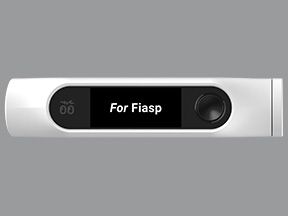Fiasp (insulin aspart) is a brand-name prescription medication. The Food and Drug Administration (FDA) has approved it to help manage blood sugar levels in adults and children with type 1 or type 2 diabetes.
The drug comes as a solution that’s injected subcutaneously. It comes in a vial, FlexTouch pen, or PenFill cartridge that’s used with certain refillable insulin pens. If your condition is being treated in a hospital, your doctor or another healthcare professional may give you an IV infusion of Fiasp.
Fiasp is a type of fast-acting insulin. It’s a
For information about Fiasp dosing, including the drug’s strength and how to take the medication, keep reading. For a comprehensive look at Fiasp, see this article.
This article describes typical dosages for Fiasp provided by the drug’s manufacturer. When taking Fiasp, always follow the dosage prescribed by your doctor.
The usual recommended dosages for Fiasp are described below. However, be sure to take the dosage your doctor prescribes.
Fiasp forms
Fiasp comes as a solution in a vial, FlexTouch pen, or PenFill cartridge that’s used with certain refillable insulin pens. If your condition is being treated in a hospital, your doctor or another healthcare professional may give you an IV infusion of Fiasp.
Fiasp strength
Each form of Fiasp comes in a strength of 100 units per milliliter (mL).
The Fiasp vial contains 10 mL of solution. The FlexTouch pen and PenFill cartridge each contain 3 mL of solution.
Typical dosages
There isn’t a typical starting dosage of Fiasp, as many factors determine your dosage. Your doctor will prescribe the dosage that’s right for you.
Typically, your doctor will start you on a low dosage. Then they’ll adjust it over time to reach the amount that’s right for you. Your doctor will ultimately prescribe the smallest dosage that provides the desired effect.
The following information describes dosages that are commonly used or recommended. However, be sure to take the dosage your doctor prescribes for you. Your doctor will determine the best dosage to fit your needs.
Dosage for type 1 diabetes
Your doctor will use your body weight in kilograms (kg)* to calculate the total amount of daily insulin you need for type 1 diabetes. They may prescribe 0.4 units to 1 unit of insulin per kg of body weight daily. This is the dosage range recommended by the American Diabetes Association.
You’ll typically take both long-acting and fast-acting insulin to treat your type 1 diabetes. Long-acting insulin releases over time. Fast-acting insulin, such as Fiasp, works quickly and helps manage your blood sugar after eating.
Your total daily dosage will be a combination of these insulin types. For example, if you weigh 60 kg (about 132 lb), your dose of insulin would likely be 24 units to 60 units per day. Your doctor will prescribe the right amount of fast-acting and short-acting insulin based on your total daily insulin needs.
* 1 kg is about 2.2 pounds (lb).
Dosage for type 2 diabetes
Your doctor will use your body weight in kg to calculate the total amount of daily insulin you need for type 2 diabetes. They may prescribe a dosage of 0.3 units to 0.5 units of insulin per kg of body weight per day. This is the dosage range recommended by the American Diabetes Association.
You’ll typically take both long-acting and fast-acting insulin to treat your type 2 diabetes. Your total daily dosage will be a combination of these insulin types. For example, if you weigh 60 kg (about 132 lb), your dose of insulin would likely be 18 units to 30 units per day. Your doctor will prescribe the right amount of fast-acting and short-acting insulin based on your total daily insulin needs.
Children’s dosage
The dosage of Fiasp to manage blood sugar levels in children with type 1 or type 2 diabetes is the same as the adult dosages. For more information, see the “Dosage for type 1 diabetes” or “Dosage for type 2 diabetes” sections above.
Long-term treatment
Fiasp is meant to be a long-term treatment. If you and your doctor determine that Fiasp is safe and effective for you, you’ll likely use it long term.
See below for answers to some common questions about Fiasp.
Is there a dosage chart for Fiasp?
Your doctor may give you an insulin dosage chart or a blood sugar log when you start Fiasp treatment. They’ll recommend that you record your insulin dosages and blood sugar levels as part of your diabetes care plan.
This can help you manage your condition. It’ll also help alert you if you have hypoglycemia (low blood sugar) or hyperglycemia (high blood sugar).
These charts and logs can also help inform your doctor about the right dosage of Fiasp for you. Tracking your Fiasp dosages and blood sugar levels can help determine whether you need a correction dose.
For example, if your blood sugar is too high, you may need a correction dose. In this example, a correction dose would be a higher amount of insulin than usual to help decrease your blood sugar to your target level. Your doctor will advise you about the right correction dose for you.
For more information about correction doses and your blood sugar target level, talk with your doctor.
Does Fiasp need to be refrigerated?
Yes, Fiasp should be refrigerated. The drug’s manufacturer recommends storing it at a temperature between 2°C and 8°C (36°F to 46°F).
Do not keep Fiasp near a freezer compartment. It should not be used if frozen. Also, the drug should not be exposed to heat.
To learn more about how Fiasp should be stored, see the drug’s prescribing information. You can also talk with your doctor or pharmacist.
How fast does a dose of Fiasp work?
Fiasp is a fast-acting insulin that works very quickly to decrease your blood sugar level. Clinical trials show that Fiasp is present in the bloodstream about 2.5 minutes after it’s administered.
Since it works quickly, it’s important to take Fiasp at the start of your meal or within 20 minutes after you begin eating.
Talk with your doctor or pharmacist about when you should take your Fiasp dose.
Is the dosing for Fiasp and NovoLog the same?
It depends. If you’re prescribed Fiasp or NovoLog,* your doctor will determine the dosage that’s right for you. Your dosage depends on several factors, such as your weight, the severity of your condition, and other medications you take. (To learn more, see the “Factors that can affect your dosage” section below.)
The American Diabetes Association makes recommendations for the daily insulin dosage for type 1 and type 2 diabetes. Your doctor will likely use these recommendations to personalize your dosage. (For more details, see the “Fiasp dosage” section above.)
NovoLog and Fiasp are both fast-acting insulins. Both drugs contain the active ingredient insulin aspart. However, they’re not interchangeable. This means that one cannot be used in place of the other because they are not identical drugs.
Fiasp also contains niacinamide (vitamin B3) and L-arginine (an amino acid). These ingredients help make it more stable and absorb more quickly in your bloodstream. Fiasp may work faster than NovoLog, which doesn’t contain these other ingredients. For this reason, Fiasp can be taken up to 20 minutes after you’ve started your meal. NovoLog would need to be given before a meal.
To learn how the dosages compare between Fiasp and NovoLog, talk with your doctor. They’ll help determine the best drug and dosage to treat your condition.
* For more information about NovoLog’s dosage, see this article.
Fiasp comes as a solution in a vial, FlexTouch pen, or PenFill cartridges for use with certain insulin pens. You’ll inject it subcutaneously at the start of your meal or within 20 minutes after you start eating.
Be sure to take your dosage of Fiasp as your doctor advises. Your doctor or pharmacist will show you how to inject Fiasp under the skin of your abdomen, upper arm, or upper thigh. They’ll likely recommend you rotate injection sites with each dose. This is to help reduce your risk of injection site reactions.*
Fiasp can also be used in an insulin pump. If your doctor recommends this type of delivery, they’ll show you how to operate the pump to give yourself doses.
If your condition is being managed in a hospital, you may receive Fiasp as an IV infusion. A doctor or another healthcare professional will administer your dose.
To learn more about how to use the different Fiasp forms, visit the drug manufacturer’s website. You can also talk with your doctor or pharmacist.
* For more information about Fiasp’s side effects, including injection site reactions, see this article.
ACCESSIBLE DRUG LABELS AND CONTAINERSIf you’re having trouble reading your prescription label, talk with your doctor or pharmacist. Some pharmacies offer labels with large print, braille, or a code you scan with a smartphone to convert text to speech. If your local pharmacy doesn’t have these options, your doctor or pharmacist might be able to recommend a pharmacy that does.
If you’re having trouble using your injection device, ask your pharmacist to review how to correctly use it to administer your dose.
The Fiasp dosage your doctor prescribes will depend on several factors. These include:
- the type and severity of the condition you’re using Fiasp to treat
- your body weight
- the form of Fiasp you use
- other medications you take
Other medical conditions you have can also affect your Fiasp dosage.
Dosage adjustments
If you have kidney or liver problems, your doctor may adjust your dose. This is because you have a higher risk of developing hypoglycemia (low blood sugar) with these conditions.
If you missed your dose of Fiasp, check your blood sugar level when you remember. This is to determine whether you’ll need to administer a dose of Fiasp. If your blood sugar is not high, take your dose of Fiasp as usual at your next meal. Continue to monitor your blood sugar as recommended by your doctor.
If you have any concerns about when to take your next dose of Fiasp after missing your dose, talk with your doctor or pharmacist.
To help make sure that you don’t miss a dose, try using a medication reminder. This can include setting an alarm, using a timer, or downloading a reminder app on your phone. Your doctor can also provide you with a dosage chart or log.* These could help you track and record your dosages of Fiasp.
* For more details about dosage charts and logs, see “Is there a dosage chart for Fiasp?” in the “Frequently asked questions” section above.
It’s important that you do not use more Fiasp than your doctor prescribes. For some medications, taking more than the recommended amount may lead to side effects or overdose.
Symptoms of an overdose
Severe hypoglycemia (extremely low blood sugar level) or hypokalemia (low potassium level) are serious side effects that can occur with an overdose.
Symptoms of low blood sugar may include:
- dizziness
- nausea
- fatigue
- sweating
- cramps or muscle twitches
- seizure
- coma
Symptoms of low potassium may include:
- irregular heartbeat
- cramps and muscle twitches
- nausea and vomiting
- urinating frequently
If you take more than the recommended amount of Fiasp
Call your doctor right away if you believe you’ve taken too much Fiasp. Another option is to call the American Association of Poison Control Centers at 800-222-1222 or use its online tool. If you have severe symptoms, immediately call 911 or your local emergency number, or go to the nearest emergency room.
The dosages in this article are typical dosages provided by the drug’s manufacturer. If your doctor thinks that Fiasp is a good insulin for you, they’ll prescribe the dosage that’s right for you. Always follow the dosage that your doctor prescribes.
As with any drug, never change your dosage of Fiasp without your doctor’s recommendation. If you have questions about the dosage of Fiasp that’s best for you, talk with your doctor.
Besides learning about dosage, you may want other information about Fiasp. These additional articles might be helpful:
- More about Fiasp. For information about other aspects of Fiasp, refer to this article.
- Side effects. To learn about the side effects of Fiasp, see this article. You can also look at the Fiasp prescribing information.
- Drug comparison. Find out how Fiasp compares with Lyumjev, which is another rapid-acting insulin used to manage blood sugar levels.
- Details about diabetes. For details about type 1 and type 2 diabetes, see our diabetes hub.
Disclaimer: Medical News Today has made every effort to make certain that all information is factually correct, comprehensive, and up to date. However, this article should not be used as a substitute for the knowledge and expertise of a licensed healthcare professional. You should always consult your doctor or another healthcare professional before taking any medication. The drug information contained herein is subject to change and is not intended to cover all possible uses, directions, precautions, warnings, drug interactions, allergic reactions, or adverse effects. The absence of warnings or other information for a given drug does not indicate that the drug or drug combination is safe, effective, or appropriate for all patients or all specific uses.




